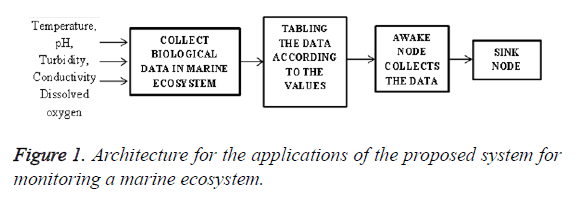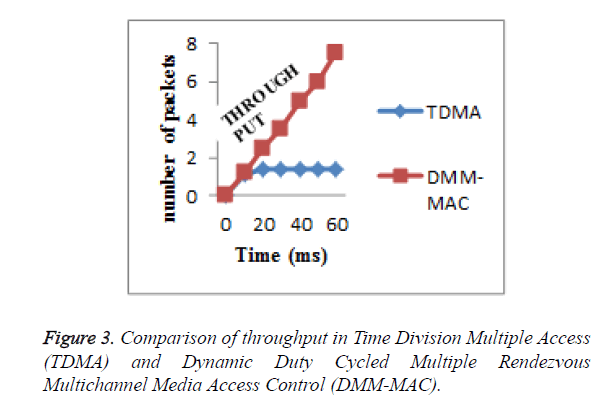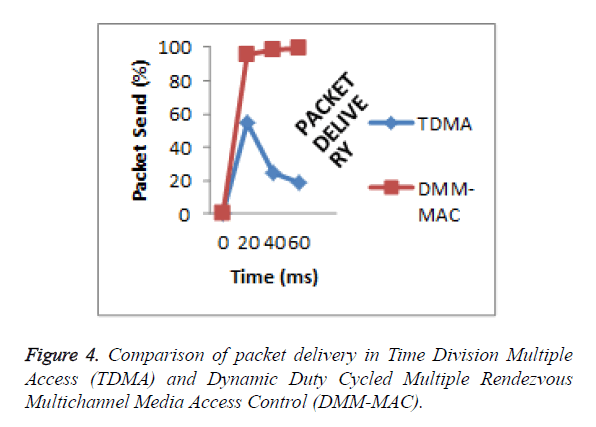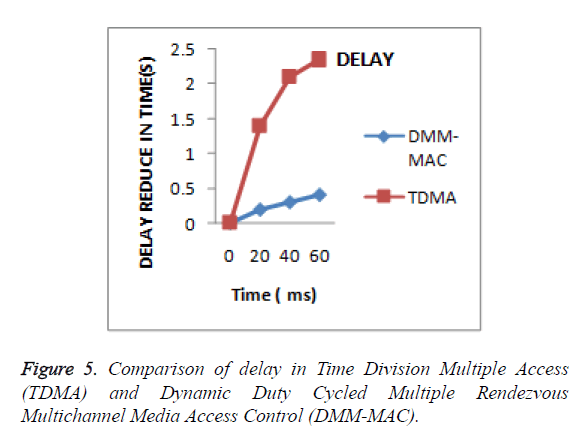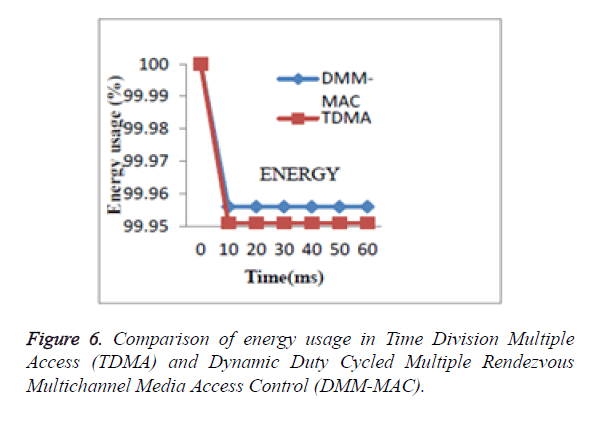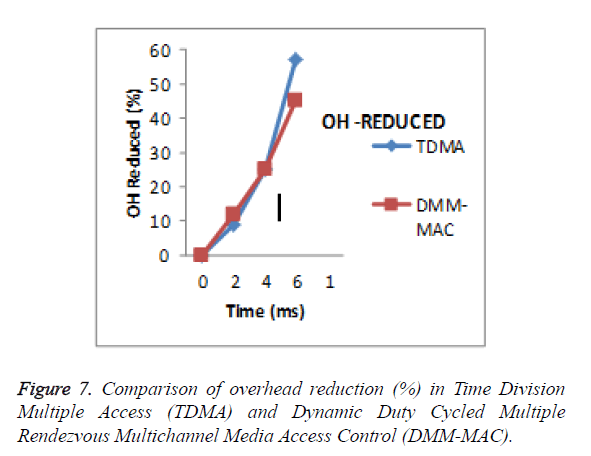ISSN: 0970-938X (Print) | 0976-1683 (Electronic)
Biomedical Research
An International Journal of Medical Sciences
Research Article - Biomedical Research (2016) Computational Life Sciences and Smarter Technological Advancement
Enhanced dynamic duty cycled multiple rendezvous multi-channel media access control (DMM-MAC) protocol for underwater sensor network based marine eco system
Department of Computer Science and Engineering, KLN College of Engineering, Pottapalayam, India
- *Corresponding Author:
- Alageswaran R
Department of Computer Science and Engineering, KLN College of Engineering, India
Accepted on August 11, 2016
Wireless Sensor Network (WSN) is a self-organized network in which sensor nodes collect the data in distributed environment. The consumption of energy and hence the life time of network is a major issue in any applications of Wireless Sensor Network (WSN) particularly in Underwater Sensor Networks (UWSN). The concept of multiple channel and duty cycling, which reduce the transmission collision and idle listening, can be used to conserve the energy. Media access control protocols such as Multiple Rendezvous Multichannel Media Access Control (MM-MAC) and Dynamic Duty Cycled Multiple Rendezvous Multichannel Media Access Control (DMM-MAC) are used for handling more volume of data in Underwater Sensor Networks (UWSN). Only one modem is used in Dynamic Duty Cycled Multiple Rendezvous Multichannel Media Access Control (DMM-MAC) and it operates in more realistic multi-hop environment, without using the information about distances or propagation delays to neighbour nodes which is considered as basic requirement for unattended wireless sensor network applications. In this paper, underwater sensor networks applied to monitor the marine ecosystem are proposed. The logic used for Dynamic Duty Cycled Multiple Rendezvous Multichannel Media Access Control (DMM-MAC) is enhanced and implemented and the results are compared with Time Division Multiple Access (TDMA) media access control which is the basis for both Multiple Rendezvous Multichannel Media Access Control (MM-MAC) and Dynamic Duty Cycled Multiple Rendezvous Multichannel Media Access Control (DMM-MAC). By employing the enhanced dynamic duty cycling, sensor nodes running Dynamic Duty Cycled Multiple Rendezvous Multichannel Media Access Control (DMM-MAC) are able to handle more volume of sensor data effectively. From the results obtained through simulation, it is observed that the delay is reduced, throughput and packet delivery rate are improved and the overhead for packet transmission is greatly reduced in Dynamic Duty Cycled Multiple Rendezvous Multichannel Media Access Control (DMM-MAC). Also Dynamic Duty Cycled Multiple Rendezvous Multichannel Media Access Control (DMM-MAC) provides better network performance than Multiple Rendezvous Multichannel Media Access Control (MM-MAC) in unattended environment.
Keywords
Underwater wireless sensor network, Marine ecosystem, Biological factors, Time division multiple access, Multiple rendezvous multichannel media access control, Dynamic duty cycled multiple rendezvous multichannel media access control.
Introduction
Due to various social developments one of the ecosystems that are drastically affected is the marine ecosystem. Earlier, oceanographic research vessels were used to monitor marine environments. These are expensive and take a long time to give any conclusive suggestions. Recently, Wireless sensor network-based approach has been applied to monitor the marine ecosystem. They improve the access to real-time data covering long periods and large geographical areas and they are much cheaper compared to traditional methods. Wireless sensor network-based marine ecosystem monitoring has a number of application areas including water quality monitoring, ocean sensing and monitoring, coral reef monitoring, etc.
Underwater Wireless Sensor Networks (UWSN) provides many applications. Underwater wireless sensor networks communicate through acoustic signal and optical signal. Underwater wireless sensor networks consist of sink node and sensor node [1]. The sensor nodes are deployed to form a connected network which collect the data and send to the master node called sink node. Transmission collision and energy consumption in idle listening must be reduced to conserve energy. Underwater Wireless Sensor Networks (UWSN) consists of detector nodes which are capable of collecting information and communicating with each other through the wireless transceivers. The Underwater wireless sensor networks consist of nodes and each node is connected to one (or several) detectors. Each such detector node has a radio transceiver with an internal antenna or connection to an outside antenna, a micro-controller, circuit for interfacing with the detectors and power source.
The research and development in the field of wireless detector networks motivate the researchers to develop the military applications [2] such as battlefield surveillance. Media access control protocol plays an important role in underwater wireless sensor networks [3]. Carrier Sense Multiple Access (CSMA) protocol is used in shred topologies and used to capture the data before sending a data. Quorum-Based Energy-Saving Media Access Control (QMAC) protocol [4] uses the mechanism similar to the power saving mode of IEEE 802.11. The slotted BiC Media Access Control (MAC) protocol proposed in [5] used in underwater acoustic networks. Multiple-rendezvous multichannel media access control protocol [6] has been designed for Underwater Sensor Networks.
The rest of the paper is organized as follows: Section II presents the literature review of media access control protocols used in Underwater Wireless Sensor Networks (UWSN). In Section III the proposed system is described. In Section IV, the results and discussion is presented and Section V concludes the paper.
Proposed System
The proposed system is applied to Underwater Wireless Sensor Networks (UWSN) used for monitoring marine ecosystem. The marine ecosystem is very diverse and they provide very useful indicators about various factors affecting the overall global environment. Various biological qualities in the marine environment like temperature, pH, turbidity, conductivity and Dissolved Oxygen (DO) etc. can be studied to overcome the harassment and destruction of underwater ecosystem and the global environment in general. This application generates large volumes of data that needs to be monitored over a long period of time to analyse the various factors affecting the marine ecosystem.
In order to handle more volume of data in a multi hop Underwater Wireless Sensor Networks (UWSN), dynamic duty-cycled multiple-rendezvous multichannel media access control protocol is used. Senor nodes with Dynamic Duty Cycled Multiple Rendezvous Multichannel Media Access Control (DMM-MAC) protocol distribute bursty sensor data by dynamically tuning the duty cycles and hence network performance is enhanced dramatically. The proposed enhanced dynamic-duty-cycled multichannel media access control protocol is equipped with one modem and the propagation delays or relative distances need not to be known by the other nodes in the network. Less energy is consumed and it is easy to forward the data using Dynamic Duty Cycled Multiple Rendezvous Multichannel Media Access Control (DMMMAC) based on priority. The architecture given in Figure 1 shows the application of the proposed system for monitoring a marine ecosystem. The first step involves the collection of biological factors from the marine environment. Here, the biological factors vary when there is a sudden change in underwater environment such as explosion, earthquake, etc. These biological factors of the water are collected at certain fixed cycles. In Dynamic Duty Cycled Multiple Rendezvous Multichannel Media Access Control (DMM-MAC) protocol, there are two conditions namely, sleep and awake. The nodes in awaken state collect the data and pass the data to the sink node. The major advantage of collecting the biological information is to avoid the disasters like tsunami, earthquake’s etc. These disasters can be identified by measuring the levels of certain water parameter values. This information is collected then tabulated and is compared with the existing and the recent values. Using this comparative process at each section it is easy to identify and overcome disaster much before their occurrence.
In Dynamic Duty Cycled Multiple Rendezvous Multichannel Media Access Control (DMM-MAC) nodes are time synchronized. A sensor node in the field knows the identifier of all of its one-hop neighbour nodes. The parameters used for the simulation is shown below in Table 1.
| Sources | Value |
|---|---|
| Media Access Control (MAC) | 802.11 |
| Antenna | Antenna/Omni antenna |
| Area | 1600 ×1600 |
| Carrier Frequency | 2.4 GHz |
| Pkt-size | 500kb |
| Packet rate | 0.01Mb, 0.02Mb....0.07Mb/s |
| Initial energy | 100J |
| Tx power and Rx power | 0.01w and 0.005w |
| Number of sources | 3 |
Table 1. The parameters used for the simulation.
Communication model
In this module sensor nodes and sink node are created and deployed in an environment. Nodes will place within the range of neighbour. If sensor nodes want to transfer data, it will send request message to neighbour. The node which is near to it will send response message.
Route discovery
The timer is used to send hello message in regular intervals. Hello message is to know about the neighbour nodes; based on the reply the data are stored in a table. In every regular interval it’s going to update the routing table based on the hello message.
Dynamic-duty-cycled multi rendezvous multichannel mac protocol
Nodes executing dynamic-duty-cycled multi rendezvous multichannel mac protocol operate in a multi-hop environment. They are equipped with one modem and do not need to know the propagation delays or relative distances of remaining nodes deployed in the environment.
Dynamic duty cycling
Dynamic duty cycling is the prime logic used in dynamic-dutycycled multi rendezvous multichannel mac protocol. The concept of duty cycling permits each and every node to modify dynamically their duty cycle. Hence more volume of data can be transmitted dynamically according to the traffic density. In this method, time is portioned into a series of cycles. One cycle consists of several frames and is subdivided into an active section and a sleep section. In each cycle, active section is nothing but the time duration in which a node wakes up and the node enters into sleep mode is called the sleep section. These active and sleep sections comprises of many frames. Initially, there are two wakeup frames. They are initial wake up frames and extended wake up frames. The initial wake up frames has the process of same duty cycle with wake up frames at first frame of the cycle. The extended wake up frames allows extending the wake up frames when there is sudden burst of traffics. Dynamic duty cycle is enhanced through simulation parameters to get better performance.
Power control technique
a) Set the maximum transmission power b) While sending RTS/CTS set maximum power as tx power c) if CTS packet is received , Checks the receive power info and Set new tx power.

Figure 2 depicts how the sink node shares the originating message after allocating time slot.
Results and Discussion
The main aim is to improve the energy efficiency and also throughput by controlling the media access control layer and physical layer. In this paper, the sink node will share the originating message at the beginning but after time slot allocation. Each node will receive the originating message, and will forward to others after updating the routing information. The route to destination will be selected based on less hop count. Figure 2 shows the originating message sharing from the sink node. After synchronization the sensor node can send the data to master node called sink node through the intermediate sensor nodes in the sensor fields. In Time Division Multiple Access (TDMA) method the node can send the data only in their own slot.
In Dynamic Duty Cycled Multiple Rendezvous Multichannel Media Access Control (DMM-MAC) the overhead is reduced. In, Time Division Multiple Access (TDMA) method, here time is divided into time slots, but unlike Time Division Multiple Access (TDMA) method each node can use the other time slot when the time slot is free. To check whether time slot is free or not, we have connected Carrier Sense Multiple Access (CSMA)/Collision Avoidance (CA) method. If node has any priority data then the node can transfer the data at beginning of time slot which may be own or others. If node not has any priority data then it will check for slot is for me or not. If slot is own slot then it can send data in second slot of main slot. If slot is others slot then it will wait for third slot in main slot with small random interval if node not detecting communication then node can transfer the data in that slot.
The performances of different technique are visualized using Xgraph. These processes are under progressive manner through various parameters viz., connection throughput, packet delivery fraction, end to end delay, energy and overhead are compared. Throughput is defined as ratio between total received packet size from a node and duration of the communication. The throughput depends on the congestion level. If the nodes tried to send the data at same time, then collision will occur. Hence no communication will be initialized. If there is less number node, tried to make communication at same time, then there may be less collision. At less collision the communication can be initialized.
Figure 3 shows the comparison result of throughput in Time Division Multiple Access (TDMA) and DMM-MAC. Here the Dynamic Duty Cycled Multiple Rendezvous Multichannel Media Access Control (DMM-MAC) gives the peek throughput and the Time Division Multiple Access (TDMA) gives a less throughput. In Time Division Multiple Access (TDMA), there is fixed time slot and data must be send or receive at the fixed time slot. If the node missed to collect or transmit the data at the fixed time then it produces less throughput rate.
Packet delivery function is the ratio, between received packet and sent packet. Figure 4 shows the comparison result of variation of packet delivery. Time Division Multiple Access (TDMA) is time division method and works in fixed time slots. The main function of Time Division Multiple Access (TDMA) is that nodes transmit and receive packet at the fixed time slots.
Node cannot transmit a data when the time slot is not its own slot. Hence the packet delivery rate is decreased in percentage. End to end delay is defined as difference between received time and sent time. Figure 5 shows the comparison result of delay in Dynamic Duty Cycled Multiple Rendezvous Multichannel (DMM) and Time Division Multiple Access (TDMA). The delay rate is increased in Time Division Multiple Access (TDMA) because each node is fixed in the time slots and these nodes can send or receive only in these slots.
Energy usage and Overhead are compared in Figures 6 and 7, respectively. The overhead is nothing but the number of extra packet used to synchronize and find the route. The energy is also taken by the combination of energy usage taken in percentage and time. Here are overhead (OH), energy level is compared with the Time Division Multiple Access (TDMA) and Dynamic Duty Cycled Multiple Rendezvous Multichannel (DMM). Time Division Multiple Access (TDMA) works in the fixed time slots. Here the sleep and awake section is also fixed. During the allocated time period the node can able to transmit the data. These nodes cannot attain extra time slots. Hence, the overhead is increased in Time Division Multiple Access (TDMA). In Dynamic Duty Cycled Multiple Rendezvous Multichannel (DMM) the overhead is reduced, because in Dynamic Duty Cycled Multiple Rendezvous Multichannel (DMM) contains two mini slots and the node can deliver the data when they are ready.
By adding Time Division Multiple Access (TDMA) with priority method, the node can use the others time slot if it has priority data. And it checks with Carrier Sense Multiple Access (CSMA) method to detect the collision, so almost we can remove the collision and we can improve the throughput. But if the data missed in one slot means it should wait for another slot. Similarly, in Dynamic Duty Cycled Multiple Rendezvous Multichannel we add the priority model, it can reduce the delay. Here there is no fixed time. Here the Dynamic Duty Cycled Multiple Rendezvous Multichannel model reduce the overhead more than the Time Division Multiple Access (TDMA).
Conclusion
An enhanced Duty Cycled Multiple Rendezvous Multichannel Media Access Control (DMM-MAC) for handling more volume of data in multi-hop Underwater Sensor Networks (UWSN) for marine eco system is proposed and analysed. In Duty Cycled Multiple Rendezvous Multichannel Media Access Control (DMM-MAC) the node switches between active and sleeps states to deliver bursty traffic. This mechanism extends the life time of the network. Major importance is given to simulate dynamic duty cycling. Without exchanging the extra control packet, this media access control achieves the bursty traffic transmission. The Multiple Rendezvous Multichannel Media Access Control (MM-MAC) during active section assures a sender can meet its intended receiver. The logic used for dynamic duty cycling in Dynamic Duty Cycled Multiple Rendezvous Multichannel Media Access Control (DMMMAC) is enhanced and simulated using NS2. Results obtained through simulation show that the performance of enhanced duty cycled Dynamic Duty Cycled Multiple Rendezvous Multichannel Media Access Control (DMM-MAC) is better than the fixed-duty-cycle Time Division Multiple Access (TDMA) in terms of throughput, end-to-end delay, and energy usage. Hence the enhanced duty cycled Duty Cycled Multiple Rendezvous Multichannel Media Access Control (DMMMAC) well suits for an Underwater Sensor Networks (UWSN) where traffic is dynamic and erratic.
References
- Chih-Min C, Yao-Zong W, Ming-Wei L. Multiple-rendezvous multichannel mac protocol design for underwater sensor networks. IEEE Trans Cyber Sys 2013; 43: 128-138.
- Chih-Min C, Yi-Wei L. A quorum-based energy-saving mac protocol design for wireless sensor networks. IEEE Trans Vehicular Technol 2010; 59: 813-822.
- Guoliang X, Tian W, Zhihui X, Weijia J. Rendezvous planning in wireless sensor networks with mobile elements. IEEE Trans Mob Comp 2008; 7: 1430-1443.
- Jinfang J, Guangjie H, Feng W, Lei S, Mohsen G. An efficient distributed trust model for wireless sensor networks. IEEE Trans parallel Distributing Sys 2015; 26: 1228-1237.
- Joseph K, Maria C. AC protocols used by wireless sensor networks and a general method of performance evaluation . International JDistrSensNetw 2012.
- Kancherla V, Ramesh Babu P, Nirupama P. RPMAC: A novel receiver pivotal media access control protocol event driven wireless sensor networks. Int J Adv Res Comp SciManag Studies 2014; 2: 85-93.
